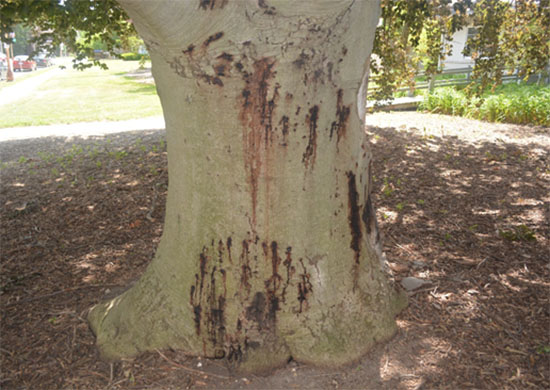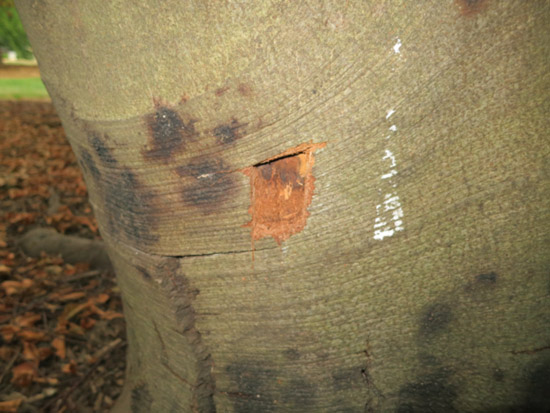Issue 9, June 26, 2017
Bleeding Canker of European Beech
The true beauty of a mature European beech is hard capture with words alone. Perhaps Michael Dirr described the tree's landscape value best in his Manual of Woody Landscape Plants- "There is no finer specimen tree; so beautiful that it overwhelms one at first glance…" European beech also offers the additional benefit of being relatively free of insect and disease problems. However, bleeding canker is an increasingly significant disease problem on many mature specimens, especially in the Northeastern states. Closer to home, I have seen several large trees on the U of I campus succumb to this threatening disease. Researchers at Cornell University have taken the lead in researching this disease. They have identified three species of Phytophthora from cankered trees. Phytophthora pini (formerly P. citricola 1), P. cactorum, and P. cambivora. Of the three, P. pini was the most frequently isolated from sampled trees. The disease rarely occurs on American beech (Fagus grandifolia).
Symptoms
Bleeding canker symptoms first appear on the lower portion of the tree's trunk as distinct, dark-colored areas of the bark. The cankers often weep or "bleed" a dark, wet, substance, especially during the spring and early summer months. The symptoms progress upward, potentially affecting bark several feet above the soil line, and on occasion some of the lower limbs.

Stained dark-colored bark associated with bleeding canker disease of European beech.
Bleeding cankers severely damage the aesthetic value of the beech tree's bark. However, the greatest injury occurs beneath the bark where the pathogen attacks and kills the inner bark and vascular tissues. Removing the cankered bark reveals discolored, brown cambial tissues. For some trees, cambial tissues develop a reddish-pink discoloration. As the bleeding canker expands, it essentially girdles the tree. The vascular disruption results in sparse, wilted, and chlorotic leaves. Severe infections predispose the tree to other pests and environmental stressors, and may result in the tree's death.

Bleeding canker with bark cut away to reveal discolored cambial tissues.

European beech tree killed as a result of bleeding cankers. The tree was planted on the high point of the slope. Drought and water stress likely contributed to disease development and ultimately, the tree’s death.
The European beech may have some natural defenses against the pathogen. Many trees appear to wall-off cankered tissues. However, the presence of bleeding cankers likely predisposes trees to greater damage from other stressors. Drought seems to be at the top of the list of potential sources of stress that contribute to tree decline and eventual death.
Disease Management
- Scout European beech trees to identify the canker during early stages of disease development.
- Avoid and alleviate any stress to the tree. Most canker diseases take advantage hosts in a weakened condition. Irrigating at-risk trees may be beneficial. A light layer of mulch will help maintain adequate soil moisture. Be careful not to suffocate the roots with heavy layers of mulch.
- Cornell University has reported good results from bark drench applications of systemic fungicides containing the active ingredient mono- and di-potassium salts of phosphorous acid mixed with a bark penetrating surfactant such as Pentra-Bark. Their research suggests applications will effectively slow canker development, but unfortunately will not cure the tree. The researchers were still able to isolate the Phytophthora pathogens from trees one year after treatment.
- To avoid injury to leaves, Cornell University suggests applying the bark spray in the spring before trees begin to bud-out.
- They recommend mixing ratio in 21:21:1 (Fungicide: Water: Surfactant).
- Apply the bark spray top down, starting 6-9 feet above ground.
(Travis Cleveland)
Author:
Travis Cleveland